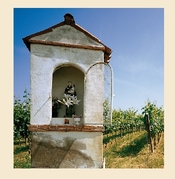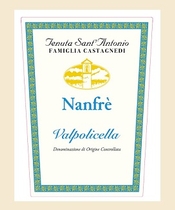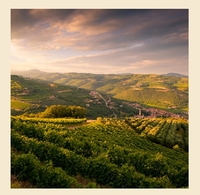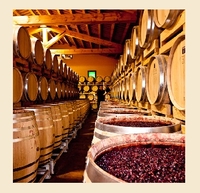Tenuta Sant’Antonio was created in 1989 by the Castagnedi brothers,

Armando, Tiziano, Paolo and Massimo. It is located on the east side of the Valpolicella appellation in the Veneto region of Italy. As Armando said recently in a virtual tasting, “We are in the place where the Soave area stops and Valpolicella begins.” The winery name has two inspirations: their father, and a small chapel in their Monti Garbi vineyards. Their father was a grape grower and one of the founders of the cooperative winery in Illase Valley. He was delighted when his sons told him they were planning to make wine. In the vineyards there was a small chapel named Saint Antonio of Badua, where the locals prayed. “So we decided, why not? This is our father, Antonio” said Armando. “The chapel is called Saint Antonio, so why not the name Sant’Antonio. This is the inspiration for the name.”
Armando notes that their winery is considered young, “because 25 years in the world of wine is nothing. When we started producing wine we were not so clear. There was enthusiasm but without a clear vision.” After a few years, they realized that they wanted to create a wine that is fresh and balanced. He continued, “Because we are in the place where wine is made generally with the old method of apassimento, drying grapes to make wine, or with the method of second fermentation on skins like Ripasso, it’s easy to have a wine with a high concentration of sugar, high alcohol, but it was not easy to create balance as a characteristic. Our research has always been in this direction.”

“Today I think the result is quite interesting,” he said, introducing Valpolicella Nanfrè 2018, their youngest selection. “The blend is 70% Corvina and 30% Rondinella from grapes selected from the youngest vines. We wanted to rediscover the original style from 30 years ago or earlier. We wanted to create a style, not necessarily strong or rich, but light with 12.5 alcohol. A wine in the style of Pinot Noir, a wine that is fruity and at the same time with some spicy notes, like pepper and a note like we have in our limestone soil. A wine for drinking in the summertime -- fresh.” The wine is fermented in temperature-controlled stainless for eight to ten days. It spends six months in stainless steel on lees stirred weekly then bottled with a glass stopper. “It is a fantastic wine for a light dinner of salumi, rice or soup. It’s a young wine for everyday occasions, also good lightly chilled.” He also likes this wine with oysters in the summer, a pairing suggested to him by a sommelier.
The next wine he offered was the Monti Garbi Valpolicella Superiore Ripasso 2017, “probably our most representative wine,” said Armondo. It displays a light ruby color with orange notes with fresh red cherry, cranberry, floral rose aromas. The flavors of cherry, strawberry fruit are, at once, savory, sweet-sour, with crisp mouthwatering acidity, salinity, both intense and lively in the mouth with ripe tannins.

Monti Garbi, located in the hills at almost 1150 feet overlooking the Illasi Valley, was the brothers’ first vineyard. Monti Garbi in the local dialect means poor, arid, sour. This is the vineyard with the little chapel where the locals prayed, apparently for water, because the soil is “arid, poor and needs irrigation especially in the summer when the vineyards are younger,” said Armondo. “The soil is completely white, limestone chalk, and rocky; this is the first characteristic of this place. For us Monti Garbi is the soil, the character of the soil,” he continued. That soil is rich in calcium carbonate, which can impart a higher acidity and bolder cherry fruit character to the wines.
He explained that they don’t have separate vineyards for grapes destined for Amarone. They first select grapes destined for Amarone, usually about 40 percent of the harvest. Those grapes go into boxes to be dried for Amarone. Next comes the selection for Ripasso. The blend in 70 percent Corvina and Corvinone, 20 percent Rondinella, and ten percent Oseleta. The freshly harvested grapes are fermented with yeasts selected from the Amarone grapes, and the resulting Valpolicella is held in tanks or barrels until the skins of the current vintage Amarone wines are available to re-ferment the new Valpolicella wine. The Ripasso wine rests in 500 liter, French-oak casks, 30 percent new and 70 percent second use, with battonage once a month, until October. This technique adds flavor, tannins and alcohol for a richer style of Valpolicella.

Armondo noted that while the tradition in Valpolicello is old barrels, they developed a regular program of replacing 300 old barrels that allows them to have a full turnover of their 2000 barrels every six or seven years, because their goal is a clean fruity, fresh style wine.
When they first started making wine, they did not have a clear vision for their Amarone, so they hired a consultant, but they found the advice too traditional. “Honestly when we started making wine it was hard to find a clean Amarone, it was always with some note of oxidation, not fruity” he said. “So we wondered why not improve this characteristic?” They wanted to create a wine with a ”balance of sugar and acidity, not jammy, not marmalade.” He recalled that often at a tasting people would say, “it’s a good wine, but not to drink with food. It was always the question. So we wondered, why not improve by creating a fresher wine, more drinkable?” They started picking the grapes earlier, working in the vineyards for lower yields. They press the macerating earlier for lower levels of sugar and alcohol. “Today many producers want to create a really rich, concentrated wine. But, I think it is really important to be able to drink a wine. If it is too alcoholic, I think it is not so interesting,” he said. “We wanted to create a wine more approachable, easier to drink, especially for people who don’t know Amarone.”
We then tasted the Amarone della Valpolicella, Antonio Castagnedi 2016 ($45). Named for their father and made from 70 percent Corvina and Corvinone, 20 percent Rondinella, five percent Croatina, and five percent Oseleta. It is a fresh wine with aromas of red cherry and blackberry, with floral notes and a touch of maple syrup and licorice. It has rich flavors of dark cherry, black plums with whispers of violets and roses, rich and smooth in the mouth. “For me it is a really interesting style, because you can introduce this wine with food. It’s not important to have a big, elaborate dish for this wine. It’s possible to drink this wine with meat, a simple steak, because it is really balanced. Sometimes my colleagues say this is not an Amarone because the original is a little sweet, but our idea was to create a wine in this style.”
The second was Amarone della Valpolicella Capogini 2015 ($66), from a single vineyard and made from their oldest vines, ones that are around 50-years old. It is a limited production wine that is not made every year. Armondo considers this their most classical Amarone. Since I’m not a big fan of classic Amarone, this was my least favorite wine of the group. The grapes spent more time drying than the Antonio Castagnedi wine. It is fermented in open barrels with indigenous yeasts for 25-30 days, then the barrels are closed, skins included for 10-18 days. Then skins are removed, and the wine is transferred to new 500 liter French oak barrels. This wine has a higher residual sugar (8 grams per liter), so they prefer the more classic Allier oak to contrast with residual sugar, giving the wine more vanilla. With a more tannic wine they prefer Navarre oak with a spicy expression. Campo dei Gigli ages three years in new casks. “These are the oldest vines, so the wine is richer, a more classic style, good with cheese, especially aged cheese or wild boar,” he said.
The final, Amarone della Valpolicella Lilium Est 2008, ($120) is produced only in the best years from 40 year-old-vines. These grapes the have the longest drying time. Sometimes they press the grapes in December, sometimes January. This is the most concentrated wine with 16 percent alcohol. It is processed in a similar process as the like Capogini, but aged in small barriques. Armondo explained that they wanted it to have different expression of more oak, to be richer and more complex. They aged the wine in new Bordeaux barrels for three years, then in bottle. In all, the wine had ten years of age before it was released, because they wanted to give the market a wine that is ready to drink. Indeed, it is a wine ready to drink and enjoy. It is powerful, but not overpowering. Richly flavorful with dried black cherry, tobacco, star anise, round and velvet texture, balanced with vibrantly crisp acidity and supported by muscular, yet burnished tannins.
Five wines, five expressions of Valpolicella from four brothers who had a vision and brought it to life. It was an educational tasting, and an inspirational story.